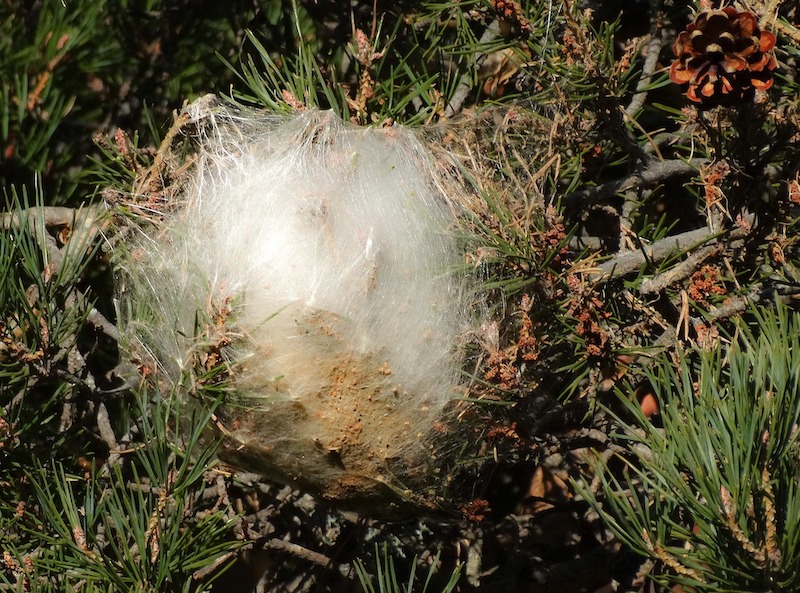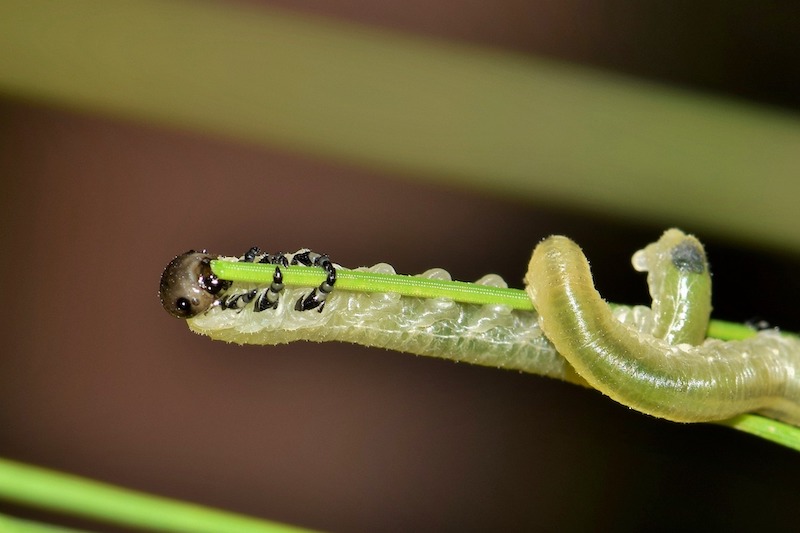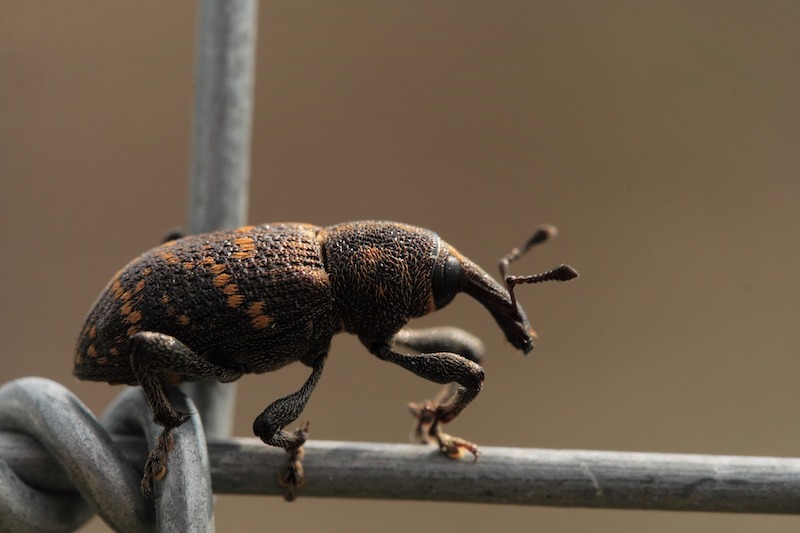Pine trees, Pinus sp., are susceptible to injury from pests in the landscape. It is important to identify and treat pine tree pests for health and aesthetic reasons. Most of the pest damage in pine trees is caused by insects, although they may be infrequently damaged by mammals such as deer. Some of the most commonly encountered insect pests of pine trees are pine webworms, sawflies, scale, tip moths, weevils, and bark borers.
For most of these pests, infestations are worse in weakened, vulnerable trees, such as those under environmental stress from poor site conditions. With proper care, prevention, and control, pests can be managed and eliminated, encouraging the growth of healthy pine trees.

Common Pine Tree Pests
Pine Webworm
Pine webworms, Pococera robustella, are common pests of pine trees in the Eastern United States. This moth defoliates pine trees, reducing the aesthetic value of these plants while negatively impacting the health of younger trees. Pine seedlings can be killed by extensive damage from pine webworms.
Caterpillars are less than an inch in length, and colored yellow-brown with dark brown bands lining their body. The pupal stage is perhaps the most noticeable life cycle stage of this pest. Cocoons are large, reddish-brown, silky cases packed with dead needles and frass. These cocoons are built on branches and stems of pine trees, and may give trees an unsightly appearance. Adult pine webworms are small, inconspicuous moths with brown and white wings. These pests are active from spring through fall.
Treating Pine Webworm on Pine Trees
In developed and mature pine trees, pine webworms are mainly an aesthetic pest and rarely affect the health of the plant. Control is usually not necessary unless desired, with the exception of seedlings. Pine webworms are a native insect, and populations are kept under control by their natural predators, such as parasitic wasps and birds. Manually remove and destroy any of the occupied cocoons. If unusually high populations of pine webworms are present, or if seedlings are threatened, trees and cocoons can be treated with registered insecticides.
Preventing Pine Webworm on Pine Trees
Pine webworms are difficult to prevent within their natural range. Environmental conditions such as water, soil, and fertilizer do little to influence pine webworm populations. The best prevention method lies in encouraging natural predators of pine webworm to visit your property. Provide appropriate habitat and food sources for birds, wasps, parasitic flies, and predatory hemipterans. Choose trees and shrubs of varying heights, and plant numerous species of flowering plants.
Pine Sawflies
There are several species of pine sawflies distributed throughout much of the contiguous United States, both native and introduced. The larvae of pine sawflies look very similar to small caterpillars, and vary in appearance based on age and species. The pupal stage of pine sawflies is typically an ovular cocoon present on the branches of pines or on the ground. Adult pine sawflies vary in color by species, but resemble small wasps in appearance.
Pine sawflies are active throughout most of the growing season, and there may be multiple generations per year. Defoliation is the most common type of damage done to pine trees across all species of sawflies. Death of pine trees can occur if populations of sawflies are particularly large, if winter buds are consumed, if infestations occur consecutively, or if young trees are targeted. Pine false webworms, a species of sawfly, cause similar damage to that of pine webworms, with silky nests filled with coppery frass and needles.

Treating Pine Sawflies on Pine Trees
Infestations are easier to treat when larvae are young. Inspect all pine trees regularly for signs of pine sawflies. Manually remove eggs, larvae, and pupae by shaking or pruning off the affected branches. Check the ground surrounding the pine tree for any overwintering cocoons.
Insecticidal soaps sprayed directly on the sawflies will also be effective. Use a labeled insecticide when infestations are severe. Despite the larvae’s caterpillar-like appearance, sawflies are in the order Hymenoptera, the same order that includes bees, ants, and wasps. It is important to know this, as insecticides such as Bacillus thuringiensis (Bt) and others labeled for caterpillar control will not be effective on sawflies.
Preventing Pine Sawflies on Pine Trees
Infestations of pine sawflies are worsened when the pine tree is under environmental stress. Provide adequate spacing for your pine trees to avoid competition for water and light. Encourage natural predators of pine sawflies to visit your property by offering plenty of habitat and food sources. Pine sawfly damage progressively worsens as the larvae grow. Regular and early detection of pine sawflies can help prevent damage before severe symptoms occur.
Pine Scale
Many species of scale insects prefer to feed on the sap of pines. Pine needle scale, Chionaspis pinifoliae, is one of most common scale pests of pine trees.Using their piercing-sucking mouthparts, these insects latch onto branches, becoming stationary. Many scales produce an abundance of a white waxy substance for protection. This gives needles and branches a white, fluffy or spotted appearance.
Some scales produce copious amounts of honeydew. This can develop into sooty mold – a sticky, black fungus that coats the plant. Severe infestations of pine scale can cause stunted growth, yellowing, wilting, and premature drop of the needles. Depending on the species, multiple generations can be present throughout the year.
Treating Pine Scale on Pine Trees
Prune out and destroy any scale-infested branches. Chemical controls work best when scale insects are young, mobile, and aphid-like. These immature scale insects are called crawlers, which is the only active stage of this pest’s life cycle. There are many insecticidal soaps available that target crawlers. Spray insecticidal soaps on affected pine trees in mid-spring after crawlers have hatched. Multiple applications may be needed if egg laying and hatching is staggered, or if multiple generations are present. Dormant oils can be applied in early spring to prevent damage to plants.
Preventing Pine Scale on Pine Trees
Pine trees are most susceptible to scale and other pests when they are growing in poor conditions. Minimize sources of stress to the trees to improve their health and pest resistance. Avoid planting pine trees in polluted areas or where there is extensive plant competition. Many insectivorous birds and predatory insects should be welcomed to prevent or control scale populations. Refrain from excessive pesticide use, especially on adult scale insects, as this can also harm their natural predators.
Pine Tip Moths
Pine tip moths, Rhyacionia frustrana, are pests of pine trees in many U.S. states. Adult moths are a quarter-inch in length, with white, gray, and orange wings. Pupae are brown and overwinter inside pine tree branches. The larvae are tan caterpillars slightly smaller than the adults and pupae.
The larval stage of this pest is the most destructive. Branch tips turn brown and die; if broken open, the inside of the tips will be hollow and sometimes filled with caterpillars or pupae. Fine webbing and resin droplets will be present at the shoot tips. Extreme infestations will cause hooked or forked growth of branches. The damage is rarely fatal, and usually only results in stunted growth and dead shoot tips. Pine tip moths are active from late winter into fall.
Treating Pine Tip Moths on Pine Trees
Pine tip moth infestations are usually not noticeable until symptoms start showing. Inspect all pine trees regularly for signs of damage, especially younger trees, which are most susceptible to pine tip moths. Prune out branches that display pine tip moth damage. Be sure to destroy the branches to eliminate any larvae and overwintering pupae that may be inside. Chemical control is rarely necessary, but look for insecticides that target caterpillars if prevention and mechanical controls do not work. Systemic insecticides tend to be the most effective for controlling pine tip moths.
Preventing Pine Tip Moths on Pine Trees
Proper site management is the best means of prevention against pine tip moths. Extensive clearing of vegetation or leaf litter surrounding pine trees may reduce populations of predators that feed on pine tip moths. Similarly, environmental stress will make pine trees prone to pine tip moth infestations. Provide pine trees with ample space to reduce competition for light, nutrients, and water. Avoid planting young pine trees near sources of pollution or roadways. Provide plenty of habitat for natural predators of pine tip moths, such as birds and parasitic wasps.
Weevils
Pine trees make suitable hosts for a few species of weevils. These beetles can be easily distinguished from other pests by their long, distinctive snouts. Adults are mottled black-brown and are less than a half inch in length. Larvae are creamy white grubs, roughly the same size as the adults. Pupae are the same color and size as the larvae.
Larvae feed on the inner bark, which damages the tree. Patches of bark may be missing from the pine tree, in addition to girdling of branches and roots. Resin often oozes from wounds caused by these weevils. Pine trees may experience wilting and dieback. One species of weevil, the white pine weevil (Pissodes strobi), targets the terminal leader of pine trees, which is the uppermost vertical branch. Terminal leaders damaged by weevils will contort into a hooked shape, and lateral branches will overtake the leader, giving affected trees a forked shape.

Treating Weevils on Pine Trees
It may be hard to detect weevils before symptoms show up, as adults are nocturnal and larvae are often concealed by bark. Inspect pine trees regularly in spring through mid-summer, when damage is at its peak. Prune out any affected branches, which can be identified by patchy or girdled bark with resin leakage. In the case of damage from white pine weevils, prune out the terminal leader in addition to all but one of the lateral branches to promote healthy single-stem dominance. Insecticides can be used in the event of severe infestation. Chemical control works best as sprays or when applied to the soil at the base of the pine tree.
Preventing Weevils on Pine Trees
Most weevils are attracted to resin from pine trees that have been recently wounded by pruning, wind, or previous pest damage. Pine trees growing in direct sunlight and younger pine trees are also frequently attacked. Therefore, do not plant new pine trees near recently wounded pine trees, as this will encourage larger infestations of weevils on the newer, younger trees.
Clearing out leaf litter surrounding pine trees may get rid of overwintering adult weevils and prevent future infestations, but keep in mind that this can negatively affect populations of beneficial insects as well. Many of these beneficial insects may be natural predators of weevils.
Bark Beetles and Borers
As the name suggests, bark beetles and borers are insect pests that damage the bark of pine trees. Though there are several species of bark beetles and borers, their life cycles and damage patterns are roughly the same. Active from spring through fall, several generations may be present each year as grubs bore under the bark, change into adults, and lay eggs within the pine tree, effectively re-infesting the tree.
Clusters of small holes will be randomly arranged in the bark of pine trees, rather than in a straight line like woodpecker holes. Holes may be plugged with pitch from the pine tree. Some species create galleries, or tunnels, beneath the bark. Since the tree’s vascular system is affected, symptoms such as needle wilting, yellowing, and drop may occur. These beetles are often vectors of harmful fungal pathogens or nematodes. In vulnerable, weak pine trees, bark beetle and borer damage can result in death of the tree.
Treating Bark Beetles and Borers on Pine Trees
Bark beetle and borer damage is always noticed before the pest itself, at which point it is too late to use cultural or mechanical controls. Registered insecticides are the most effective way to eliminate bark beetles and borers. Timing is crucial for chemical controls, as larvae and pupae are hidden beneath the bark. This makes it difficult for many insecticidal sprays to reach the larvae and pupae.
For best results, insecticides with residual activity should be used during peak adult activity in spring and summer. This will greatly reduce risk of re-infestation. Multiple applications may be needed to coincide with numerous generations. In the case of severe infestations, remove and destroy entire pine trees to protect neighboring pines.
Preventing Bark Beetles and Borers on Pine Trees
Proper plant care is the greatest way to prevent infestations of pine beetles and borers. Pine trees exude resinous pitch at the site of wounds caused by the beetles, which pushes the beetles out and prevents significant damage. Pine trees that do not receive sufficient sunlight or water will be unable to produce enough pitch to remove bark beetles. Plant pine trees in direct sun and water them deeply, especially during periods of drought. Avoid mechanically injuring pine trees, which can attract bark beetles and borers.
Pine Tree Pests Chart
|
Pest |
Identifying |
Treating |
|
Pine Webworm |
Cocoons are large, reddish-brown, silky cases packed with dead needles and frass |
Manually remove and destroy any of the occupied cocoons |
|
Pine Sawflies |
Larvae vary in appearance based on age and species, adult pine sawflies vary in color by species, but resemble small wasps |
Shake or prune off the affected branches or apply insecticidal soap |
|
Pine Scale |
Small lump with abundance of white waxy substance for protection |
Prune out and destroy any scale-infested branches |
|
Pine Tip Moths |
Tan caterpillars slightly smaller than the adults and pupae |
Prune out branches that are damaged and destroy any larvae in sight |
|
Weevils |
Beetles that has long, distinctive snouts, mottled black-brown and are less than a half inch in length |
Prune out any affected branches or use insecticide with severe infestation |
|
Bark Beetles and Borers |
Clusters of small holes randomly arranged, galleries, or tunnels, beneath the bark |
Use insecticides with residual activity, should be used during peak adult activity in spring and summer |
Sources:
"A Field Guide To Identifying The Most Common Forest Pests Of Pine Plantations." Alabama Forestry Commission. forestry.alabama.gov
"Pine (Pinus)." Connecticut State - The Connecticut Agricultural Experiment Station. portal.ct.gov
 |
Lauren Youngcourt - Published 03-23-2023 |
